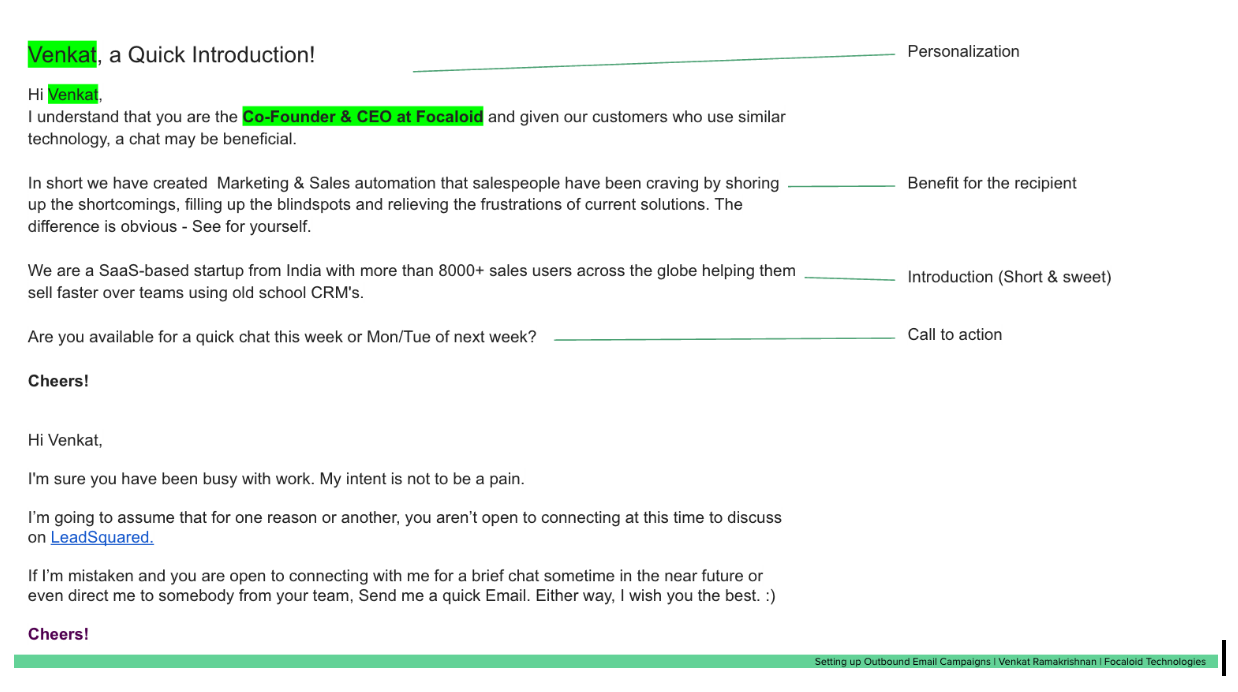
When it comes to reaching out to a potential lead without a previous relationship, the task can often seem daunting, and if done incorrectly, the results are lukewarm at best. Most companies don’t have the time or inclination to respond to every email out of the dozens they receive every day, especially if they sound overly sales-y and impersonal. This highlights the importance of having a clear strategy for outbound email campaigns, one that will resonate with your target, and make it clear to them that they can benefit from your interaction.
Venkat Ramakrishnan, co-Founder and CEO, Focaloid Technologies shared some important insights into the basics for us. Here’s what we learned.
The four main things to consider when reaching out to someone via email are who are we reaching out to, what are we sending them, how do we reach out to them, and whether the strategy is working.
Who Do We Reach Out To?
The first step is to create a list of prospects whom you want to reach out to. To do this, you should start with identifying the target company’s (accounts), and the people within those companies that you want to reach (leads). Once identified, research the contact information for each of these leads by using Linkedin to create a database.
A really great way to do this is by learning how to x-ray search Linkedin (although this may not be relevant for those who use Linkedin Premium or Sales Navigator accounts). In some cases, looking through the company’s website can also help with this step, as most companies have a Meet the Team or Contact Us page, and some may even have organisation charts online.
Once you have a good idea of who your leads are, you have to verify their email addresses. You can use a tool like Name2Email from Clearbit to guess email ids and use Rapportive, Clearbit Connect, or Email Hunter to validate them.
What do we send to them?
Now we come to content. Content is the most important part of an email campaign, so for this step you can either choose to do it yourself or hire a professional agency. There are also several free email templates available on the internet which you can choose to modify and use, including:
Yesware, ReplyApp, Hubspot, Breakthrough Email, and Thrivehive
Some tips for effective content writing:
- Use short, specific, and personalised subject lines.
- The content and the subject line should be congruent with each other.
Personalise content: use first names, company names, and any anecdotes that show the reader that you have done your research and put effort into reaching out to them. - Short, simple and sweet: be concise and ensure that the mail is easy enough to read on a smartphone.
- One simple call to action—make it as easy as possible to respond to.
- Avoid HTML content and use plain text instead.
- Enable instant opt-out by including links in every email.

Here’s an example of what Venkat would consider a good outbound email. It utilises his name, designation and company, demonstrating that the writer has done his research, it is personalised, clearly highlights what the recipient has to gain from the interaction, and has a simple call to action. The writer also remembered to follow up, which is arguably one of the most important things you can do to prevent being overlooked.
Another interesting insight comes from Vibhushan Waghmare, a consultant at YOptima, who suggests that sometimes, writing to the wrong person in the organisation might get you closer to your goal than reaching out directly.
For example, if you are looking for the sales manager in a company, send email to the tech or project manager. The email should contain just a line or two about what product/service you are offering, and the call to action would be “can you point me to the right person in your company to talk about this”.
About 50% of the time the person will forward your email to the sales manager (hopefully with a CC to you). Now you have reached the sales guy with an internal referral of some sort and therefore with better chances of getting into a conversation. If the person does not forward your email, you can then send it directly to the sales guy.
Another example: Suppose there are two co-founders—one looking after tech and the other after business—and you are selling a tech product. Write to the business guy first, and immediately within an hour or so, forward the same email to the real prospect (tech director) with a line that says:
“I wrote to [first name of business director], but realised that you would be the decision-maker for [value-prop of your tech product in 4-5 words] for [company name]. Hence, reaching out to you.”
This has often got both co-founders to talk about your product, and then you get a yes/no answer soon. Also, the tech director has now got a small ego-boost, so he tends to evaluate the product using his tech capabilities, helping you move from the reaching-out to the evaluation stage.
How do we reach out to them?
Although there are several tools available to help you meet your goals, the level of automation will depend largely on the scale of operations. Before investing in serious online tools, get into the habit of handling things manually and introduce tools gradually so as to not get overwhelmed or distracted from your end goal. Make sure you prioritise your goals based on your individual needs.
Here are some tools that may be helpful in setting up your own campaign, categorised by the level of investment and automation in operations.
Level 1: Manual
Canned responses in Gmail: Eliminates the need to copy/paste identical or similar messages in a new window, by allowing you to write and save templates for future use.
Campaign tracker: This is a simple spreadsheet based tracker to manage email campaigns.
Level 2: Minimal Automations
Mail Merge with scheduling: This tool lets you schedule emails and also track analytics using Google spreadsheets. Its free for up to 50 emails a day and is priced very low. However, it does not allow you to do follow ups.
Level 3: Automated
There are also a whole lot of tools designed to automate the entire outbound email campaign. These are paid tools and are useful when you are scaling up and include ReplyApp, Woodpecker, Quickmail, and Outreach.
Not accounting for variations in timelines and content based on your specific needs, a typical outbound email campaign will look like this:
- Day 1: Intro email.
- Day 3: Follow up email as a reply to the original email.
- Day 6: Follow up email as a reply to the original mail thread.
- Day 10: Customised email (New thread)
- Day 15: Follow up email as a reply to the 2nd email thread
and so on…
Also, Here’s A Top-10 Checklist
It will be helpful to go through this checklist before you hit start – (Courtesy Oleg Campbell, Reply.io)
- Your have written clear and to-the-point messages and follow ups.
- The prospect list is highly targeted and enriched with leads’ info.
- Email copies are personalised (with custom variables or manually).
- Every email address is validated before sending.
- All emails look 100% manually typed.
- You provide value to your prospects.
- Emails are sent directly from your email server.
- Automatic follow ups are set to go out when needed.
- Opt-out link is included to email copies at all steps.
- You process replies ASAP
Is It Working?
The final step is to make sure that your efforts are in fact, giving results. Here are some strategies to get you thinking about how to optimise your campaign to get the best results and measure your success in concrete ways.
Tracking metrics: You can track the following metrics to better gauge the success of your campaign. Of course, different tools will give you access to different metrics.
Positive reply rate: This is the result you want, keep doing what you’re doing!
Negative reply rate: Too many negative replies might reflect the need for refining your target definition.
Spam rate: Low deliverability of emails could be due to poor reputation, poor choice of content, or sending habits (eg. sending the same email to 50 people in the organisation).
Bounce rate: A high bounce rate indicates the need for more rigorous data cleansing. High bounce rate can affect the reputation of your domain.
Finetuning
Based on the data you have analysed in the previous step, you can improve your campaign by following these steps:
Subject lines: Try different subject lines with varying degrees of personalisation and customisation. Clickbait subject lines may get you open emails, but will not give you replies.
Email content: Try different email content based on target persona. Different benefits and call to action should be provided to different people in the same organisation based on their designation and role.
Email sequence: Try changing the frequency of emails. Define the frequency based on the nature of your business—for a product with a short sales cycle 5-6 emails in a 2-week period might be considered all right. But the same might be perceived as annoying for a product with a longer sales cycle.
Delivery timing: Try changing the day and time when your emails are sent based on your target geography. Eg. Mondays and Fridays are generally considered low response days, but in the Middle East, Mondays deliver a good response rate.
[This post first appeared on 91springboard.com and has been reproduced with permission. 91springboard is a vibrant coworking community created for startups, freelancers and business owners with a startup mindset.]


























